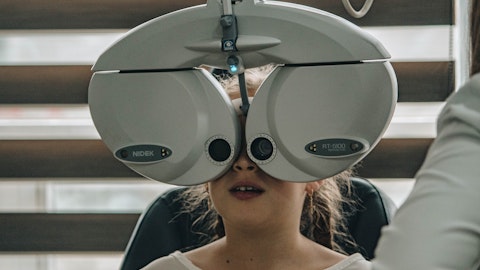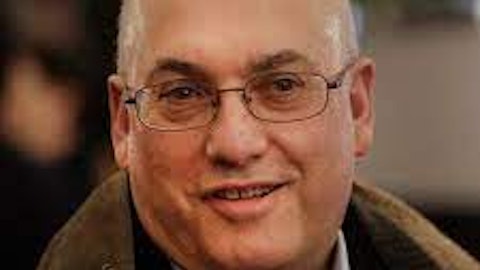Tom Stephan: Got it. That’s helpful. And then, Ali, I appreciate all the color on guidance. But I was wondering if maybe you could potentially give us a little bit more on the quarterly cadence. I know 2Q and 4Q bears a seasonal benefit. But I guess for 1Q specifically, how should we be thinking about revenue or growth? And then my tack on to that would just be, will there be any sort of, I guess, call it, a stocking benefit to consider as customers worked down inventory in the back half of last year?
Ali Bauerlein: Yes, sure. So taking the stocking question first, we really haven’t seen material changes in stocking yet. We’ve seen a return of regular ordering and improvement of utilization tied to procedure volumes. But we haven’t seen that uptick associated with just increasing their inventory levels. That may be something that we see in the future. That’s not something that we’ve inherently baked into guidance or we think would be too material in nature but that certainly is a potential that could occur at some point in time. In terms of the quarterly cadence, as we said, we do expect the first half to be down. Primarily, the second quarter is the biggest challenge from a comp perspective for us. So looking at the first quarter with the increase in utilization and the recovery that we’re seeing, typically, you would see Q1 down from Q4.
I don’t think that we’ll see that this year, may be similar but we do expect to see nice start to the year given those overall dynamics of usually utilization being down sequentially versus the fourth quarter.
Tom Stephan: Congrats on the results.
Ali Bauerlein: Thank you.
Operator: [Operator Instructions] Our next question is from David Saxon with Needham & Company.
David Saxon: I wanted to follow up on utilization, specifically for the accounts that are coming back to OMNI that maybe dropped off in the back half of last year. Are they going back to levels that they were at before? How does that typically trend? I know it’s early days still but would love to kind of hear what you’re seeing there.
Matt Link: This is Matt. I’ll take that. So as I sort of reiterated the earlier comments, I mean, it’s obviously early but I think we’re encouraged by seeing a steady cadence of a return to more sort of natural ordering patterns. And so I think everybody could appreciate under the sort of cloud or uncertainty of the LCDs in the second half of last year, in particular Q4 and uncertainty as to the final effective date of those LCDs which obviously were fortunately ultimately withdrawn, there definitely were some efforts by accounts to manage inventory, ensuring that there wasn’t excess inventory on the shelf. And again, while I think our sales organization did a phenomenal job staying in front of our customers and supporting them through that period of uncertainty, it obviously contributed to a decline, not just in OMNI utilization but MIGS in general in the second half and fourth quarter of last year.
So again, early, early days but what we are seeing is a steady state of recovery trending towards what we anticipate will be more normal ordering patterns into the question around stocking, not so much bulk stocking but again, a regular cadence of ordering, maintaining inventory in support of a broader utilization of OMNI and that’s what we’re building towards through the balance of the year.
David Saxon: Okay, great. Super helpful. And then I wanted to ask on Dry Eye. Ali, I think you said it’s going to be down significantly. I guess, what’s assumed in terms of SmartHub placements? Or is the sales force being incentivized to put out new placements? Or is revenue essentially being driven just by TearCare consumables? And then, just on the reimbursement front. When you talk to your, I don’t know, 370 or whatever it was, active accounts, about reimbursement, what are they saying in terms of where that needs to shake out in order for it to be an attractive procedure?
Ali Bauerlein: Yes. So looking at the per care side of the business and inherent in guidance, it’s really our 2024 guidance assumes that most of the revenue was coming from the sale of SmartLids and there is still a minimal number of new accounts being added but that is significantly smaller than what we saw in 2023 and 2022. So that is the shift and that is the reason that we expect to see the decline in revenue of that business along with the resizing of the sales force that occurred in October. In terms of the 327 accounts that we had on the TearCare side of the business in the fourth quarter, we don’t — we’re still working with payers. It’s too early for us to say what the appropriate reimbursement will be for that. We think we have a compelling value proposition, compelling clinical data but those conversations are just starting really now.
So to talk about pricing would be premature. But we know that already, the business model was effective on a cash pay market. So we think that there is a financial model that will work for us, will work for the patients, the providers and, of course, our customers that are doing those procedures.
Paul Badawi: Yes. I’d just like to add to that on the health economics front, we’ve prepared a very solid budget impact model for TearCare comparing the health economics of TearCare to other prescription eye drops like Restasis and others. And what the ultimate system savings would be, we submitted that budget impact model for presentation at the leading society meeting in this area is for International Society of Pharmacoeconomic and Outcomes Research. That will be presented in May in Atlanta. We’re excited about that. The budget impact model should be submitted for publication very soon to a leading managed care journal. So between the SAHARA 6-month data, the SAHARA 12-month data, crossover, where all the Restasis patients were crossed over to TearCare, a single TearCare treatment and the compelling outcomes we saw there that should hopefully soon also be published, coupled with the budget impact model, coupled with our market access team across the country that’s working with leading dry eye accounts and our sales team and providers and payers across the country, both commercial and MAC, very excited about what progress we’re going to make this year on the reimbursement side.



